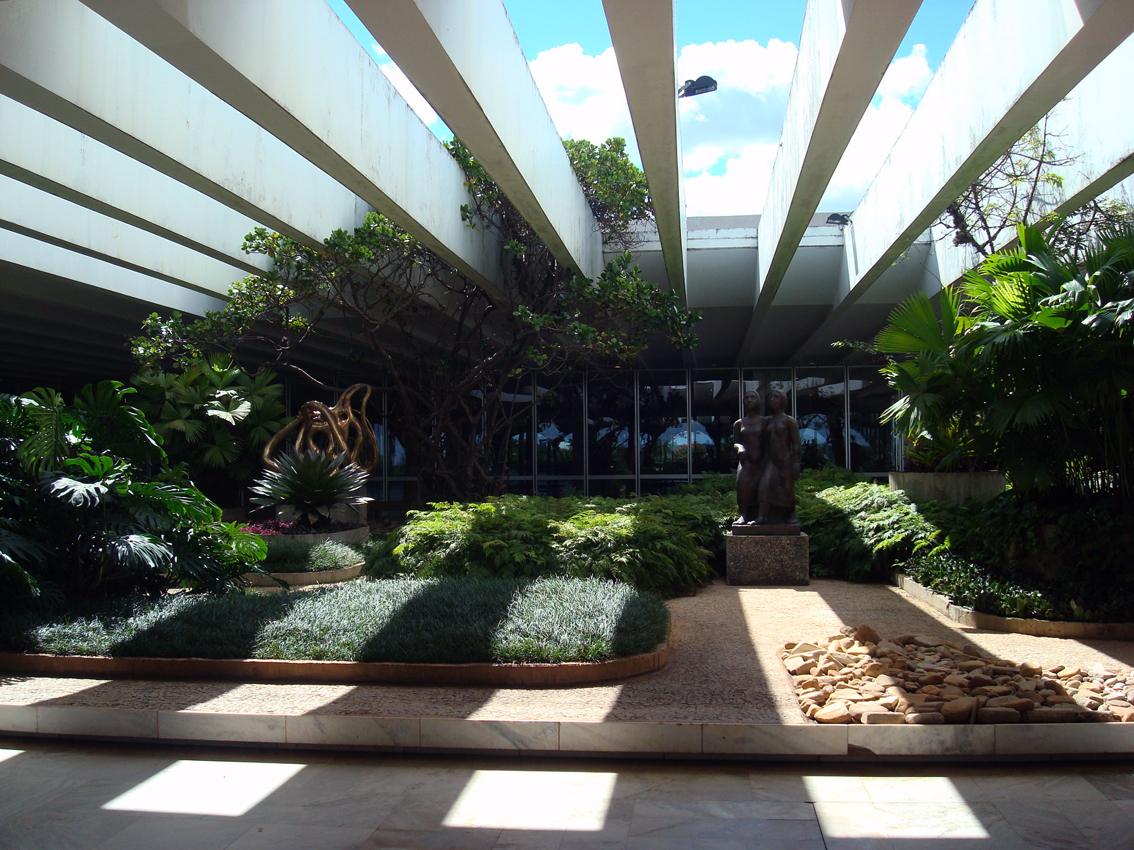|
History Of Brasília
Brasília, the capital city of Brazil located in the nation’s Federal District (Brazil), Federal District, has a history beginning in the colonial era and interactions with the native inhabitants of the area. The first propositions of relocating Brazil's capital began in the late 18th century, and after various plans and attempts at settlement, the city was inaugurated on 21 April 1960 following a four year construction period. Since its inauguration, the city has faced economic, social and political challenges and has seen vast population growth and spreading urbanisation. Since the end of the 20th century, however, Brasília has become an important cultural hub through contributions of music, art and literature. Early history The area where Brasília was established within the Goiás, State of Goias had a long history of Indigenous inhabitance and held importance during the colonial era. The State of Goias was originally designated as a Captaincy of the Viceroyalty of Brazil ... [...More Info...] [...Related Items...] OR: [Wikipedia] [Google] [Baidu] |
Brasília
Brasília ( ; ) is the capital city, capital of Brazil and Federal District (Brazil), Federal District. Located in the Brazilian highlands in the country's Central-West Region, Brazil, Central-West region, it was founded by President Juscelino Kubitschek on 21 April 1960, to replace Rio de Janeiro as the national capital. Brasília is Brazil's List of cities in Brazil by population, third-most populous city after São Paulo and Rio de Janeiro, with a population of 2.8 million. Among major Latin American cities, it has the highest GDP per capita. Brasília is a Planned community, planned city developed by Lúcio Costa, Oscar Niemeyer and Joaquim Cardozo in 1956 in a scheme to move the capital from Rio de Janeiro to a more central location. The landscape architect was Roberto Burle Marx. The city's design divides it into numbered blocks as well as sectors for specified activities, such as the Hotel Sector, the Banking Sector, and the Embassy Sector. Brasília was inscribed as a UN ... [...More Info...] [...Related Items...] OR: [Wikipedia] [Google] [Baidu] |
Luís Cruls
Luíz Cruls or Luís Cruls or Louis Ferdinand Cruls (21 January 1848 – 21 June 1908) was a Belgian- Brazilian astronomer and geodesist. He was Director of the Brazilian National Observatory from 1881 to 1908, led the commission charged with the survey and selection of a future site for the capital of Brazil in the Central Plateau, and was co-discoverer of the Great Comet of 1882. Cruls was also an active proponent of efforts to accurately measure solar parallax and towards that end led a Brazilian team in their observations of 1882 Transit of Venus in Punta Arenas, Chile. Early life Cruls was born in 1848 in Diest, Belgium, the son of Philippe Augustin Guillaume Cruls (a civil engineer) and Anne Elizabeth Jordens. From 1863 to 1868, Cruls studied civil engineering at the University of Ghent. In 1869 he undertook training as a military engineer and officer, graduating as a 2nd Lieutenant. Cruls served in the Belgian army, attaining the rank of 1st Lieutenant, until 187 ... [...More Info...] [...Related Items...] OR: [Wikipedia] [Google] [Baidu] |
Vista Parcial Do Distrito Federal, Brasil
Vista may refer to: Software *Windows Vista, the line of Microsoft Windows client operating systems released in 2006 and 2007 * VistA, (Veterans Health Information Systems and Technology Architecture) a medical records system of the United States Department of Veterans Affairs and others worldwide * VISTA (comparative genomics), software tools for genome analysis and genomic sequence comparisons * VistaPro, and Vista, 3D landscape generation software for the Amiga and PC * VIsualizing STructures And Sequences, bioinformatics software Organizations and institutions * Vista Group, a New Zealand software company specializing in solutions for the cinema industry * AmeriCorps VISTA, a national service program to fight poverty through local government agencies and non-profit organizations * Ventura Intercity Service Transit Authority, a public transportation agency in Ventura County, California, US *Vista Community College, now Berkeley City College, a community college in Berkeley, Cal ... [...More Info...] [...Related Items...] OR: [Wikipedia] [Google] [Baidu] |
Futurism
Futurism ( ) was an Art movement, artistic and social movement that originated in Italy, and to a lesser extent in other countries, in the early 20th century. It emphasized dynamism, speed, technology, youth, violence, and objects such as the car, the airplane, and the industrial city. Its key figures included Italian artists Filippo Tommaso Marinetti, Umberto Boccioni, Carlo Carrà, Fortunato Depero, Gino Severini, Giacomo Balla, and Luigi Russolo. Italian Futurism glorified modernity and, according to its doctrine, "aimed to liberate Italy from the weight of its past." Important Futurist works included Marinetti's 1909 ''Manifesto of Futurism'', Boccioni's 1913 sculpture ''Unique Forms of Continuity in Space'', Balla's 1913–1914 painting ''Abstract Speed + Sound'', and Russolo's ''The Art of Noises'' (1913). Although Futurism was largely an Italian phenomenon, parallel movements emerged in Russia, where some Russian Futurism , Russian Futurists would later go on to found gr ... [...More Info...] [...Related Items...] OR: [Wikipedia] [Google] [Baidu] |
Modernism
Modernism was an early 20th-century movement in literature, visual arts, and music that emphasized experimentation, abstraction, and Subjectivity and objectivity (philosophy), subjective experience. Philosophy, politics, architecture, and social issues were all aspects of this movement. Modernism centered around beliefs in a "growing Marx's theory of alienation, alienation" from prevailing "morality, optimism, and Convention (norm), convention" and a desire to change how "social organization, human beings in a society interact and live together". The modernist movement emerged during the late 19th century in response to significant changes in Western culture, including secularization and the growing influence of science. It is characterized by a self-conscious rejection of tradition and the search for newer means of cultural expressions, cultural expression. Modernism was influenced by widespread technological innovation, industrialization, and urbanization, as well as the cul ... [...More Info...] [...Related Items...] OR: [Wikipedia] [Google] [Baidu] |
Roberto Burle Marx
Roberto Burle Marx (August 4, 1909 – June 4, 1994) was a Brazilian landscape architect (as well as a painter, print maker, ecologist, naturalist, artist and musician) whose designs of parks and gardens made him world-famous. He is credited with having introduced modernist landscape architecture to Brazil. He was known as a modern nature artist and a public urban space designer. His work had a great influence on tropical garden design in the 20th century. Water gardens were a popular theme in his work. He was deftly able to transfer traditional artistic expressions such as graphic design, tapestry and folk art into his landscape designs. He also designed fabrics, jewellery and stage sets. He was one of the first people to call for the conservation of Brazil's rainforests. More than 50 plants bear his name. He amassed a substantial collection of plants at his home, including more than 500 philodendrons, including some that were discovered by him or bear his name, like '' Ph ... [...More Info...] [...Related Items...] OR: [Wikipedia] [Google] [Baidu] |
Oscar Niemeyer
Oscar Ribeiro de Almeida Niemeyer Soares Filho (15 December 1907 – 5 December 2012), known as Oscar Niemeyer (), was a Brazilian architect considered to be one of the key figures in the development of modern architecture. Niemeyer was best known for his design of civic buildings for Brasília, a planned city that became Brazil's capital in 1960, as well as his collaboration with other architects on the headquarters of the United Nations in New York. His exploration of the aesthetic possibilities of reinforced concrete was highly influential in the late 20th and early 21st centuries. Both lauded and criticized for being a "sculptor of monuments", Niemeyer was hailed as a great artist and one of the greatest architects of his generation by his supporters. He said his architecture was strongly influenced by Le Corbusier, but in an interview, assured that this "didn't prevent [his] architecture from going in a different direction".Salvaing, Matthieu (2002) ''Oscar Niemeyer'' ... [...More Info...] [...Related Items...] OR: [Wikipedia] [Google] [Baidu] |
Lúcio Costa
Lúcio Marçal Ferreira Ribeiro Lima Costa (27 February 1902 – 13 June 1998) was a Brazilian architect and urban planner, best known for his plan for Brasília. Early life Costa was born in Toulon, France, the son of Brazilian parents. His father Joaquim Ribeiro da Costa, from Salvador, was a naval engineer, and his mother Alina Ferreira da Costa, was from Manaus. He was educated at the Royal Grammar School, Newcastle upon Tyne, England, and at the ''Collège National'' in Montreux, Switzerland, until 1916, he graduated as an architect in 1924 from the National School of Fine Arts in Rio de Janeiro. After some early works in the eclectic manner, he adopted Modernism in 1929. Career In 1930, Costa established a partnership with Russian-born Brazilian architect Gregori Warchavchik, and also became the Director of the National School of Fine Arts where he had studied. Even though he found students eager to be taught in the "new style," his ruthless administration won him ... [...More Info...] [...Related Items...] OR: [Wikipedia] [Google] [Baidu] |
São Paulo
São Paulo (; ; Portuguese for 'Paul the Apostle, Saint Paul') is the capital of the São Paulo (state), state of São Paulo, as well as the List of cities in Brazil by population, most populous city in Brazil, the List of largest cities in the Americas, Americas, and both the Western Hemisphere, Western and Southern Hemispheres. Listed by the Globalization and World Cities Research Network (GaWC) as an global city, alpha global city, it exerts substantial international influence in commerce, finance, arts, and entertainment. It is the List of largest cities#List, largest urban area by population outside Asia and the most populous Geographical distribution of Portuguese speakers, Portuguese-speaking city in the world. The city's name honors Paul the Apostle and people from the city are known as ''paulistanos''. The city's Latin motto is ''Non ducor, duco'', which translates as "I am not led, I lead." Founded in 1554 by Jesuit priests, the city was the center of the ''bandeirant ... [...More Info...] [...Related Items...] OR: [Wikipedia] [Google] [Baidu] |
Urbanization
Urbanization (or urbanisation in British English) is the population shift from Rural area, rural to urban areas, the corresponding decrease in the proportion of people living in rural areas, and the ways in which societies adapt to this change. It can also mean population growth in urban areas instead of rural ones. It is predominantly the process by which towns and City, cities are formed and become larger as more people begin to live and work in central areas. Although the two concepts are sometimes used interchangeably, urbanization should be distinguished from Urban sprawl, urban growth. Urbanization refers to the ''proportion'' of the total national population living in areas classified as urban, whereas urban growth strictly refers to the ''absolute'' number of people living in those areas. It is predicted that by 2050, about 64% of the developing world and 86% of the developed world will be urbanized. This is predicted to generate artificial scarcities of land, lack of dr ... [...More Info...] [...Related Items...] OR: [Wikipedia] [Google] [Baidu] |
Industrialisation
Industrialisation ( UK) or industrialization ( US) is the period of social and economic change that transforms a human group from an agrarian society into an industrial society. This involves an extensive reorganisation of an economy for the purpose of manufacturing. Industrialisation is associated with increase of polluting industries heavily dependent on fossil fuels. With the increasing focus on sustainable development and green industrial policy practices, industrialisation increasingly includes technological leapfrogging, with direct investment in more advanced, cleaner technologies. The reorganisation of the economy has many unintended consequences both economically and socially. As industrial workers' incomes rise, markets for consumer goods and services of all kinds tend to expand and provide a further stimulus to industrial investment and economic growth. Moreover, family structures tend to shift as extended families tend to no longer live together in one hous ... [...More Info...] [...Related Items...] OR: [Wikipedia] [Google] [Baidu] |






